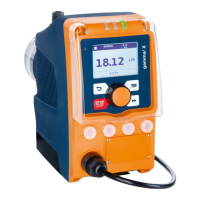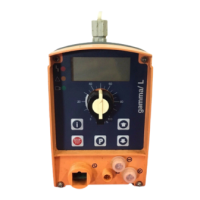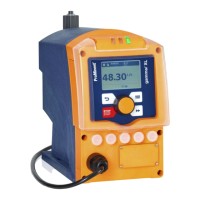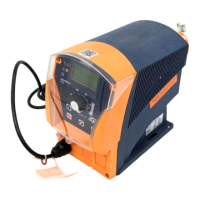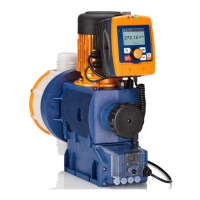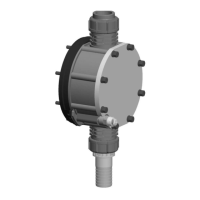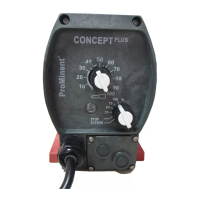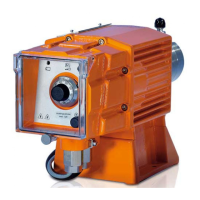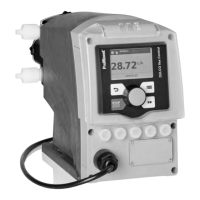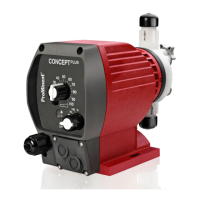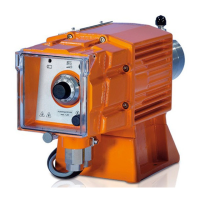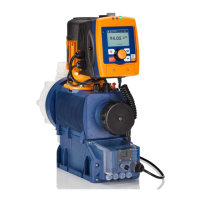Set up / ‘Menu’ Page: 52 ‘Information’ Describes the 'Information' menu, which provides details on pump parameters and counters.
‘Settings’ Details the extensive 'Settings' menu, covering operating modes, calibration, system configuration, and more.
‘Operating mode’ Explains the 'Operating mode' settings, including Manual, Contact, and the adaptive/memory functions.
‘Manual’ Describes the 'Manual' operating mode for direct pump control and setting capacity/stroke rate.
‘Contact’ Details the 'Contact' operating mode for triggering strokes via external pulses and its adaptive/memory features.
‘Batch’ Explains the 'Batch' operating mode for pre-selecting large metering volumes and triggering strokes.
‘Analog’ (option) Describes the 'Analog' operating mode for controlling pump capacity via current signals (0-20mA, 4-20mA, Linear curve, etc.).
‘Automatic’ Explains the 'Automatic' operating mode for setting direct values like capacity, volume, or time, instead of stroke length/rate.
‘Stroke length’ Details how to manually enter and adjust the stroke length for precise metering control.
Metering Covers settings related to metering, including discharge stroke profiles (optimum, fast, sine mode, etc.).
‘Discharge stroke’ Explains how to match the pump metering flow to application requirements by selecting discharge stroke profiles.
‘Suction stroke’ Details how to adjust the suction stroke to prevent inaccurate metering with high viscosity or gaseous chemicals.
‘Pressure rating’ Explains the programmable 'Pressure rating' function to reduce pump pressure and minimize rupture risk.
‘Monitoring’ Covers monitoring functions like Air lock, Sensitivity air detect, Message with overpressure, and Cavitation.
‘Air lock’ Explains how to handle 'Air lock' messages, indicating gas in the liquid end.
‘Sensitivity air detect’ Details the 'Sensitivity air detect' function for adjusting air detection sensitivity to minimize false alarms.
Compensation Describes the 'Compensation' function to minimize back pressure oscillations for improved dosing precision.
Concentration Explains how to set the desired mass concentration of feed chemical in the dissolving medium.
Calibrate Guides on pump calibration procedures, including using calibration factors and calibration by measurement.
System Settings Covers system configuration including dosing head, volume unit, pressure unit, and pressure adjustment.
Start behaviour Defines the pump's start behaviour after power supply is switched on (always STOP, always on, last status).
Inputs/outputs Details the configuration of inputs and outputs, including auxiliary capacity, relays, flow monitor, and pause input.
‘Relay1 (optional)’ Describes the setting options for Relay1, available only if a relay is fitted.
mA output Explains how to configure output signals similar to pump capacity and set pump response behavior.
‘Flow control’ Describes the 'Flow control' function, available if a flow control is installed.
‘Diaphragm rupture’ Explains how to configure the pump to generate a warning or error message upon diaphragm rupture.
‘Pause input’ Details how to select pump switching behavior for 'Pause' using input contact signals.
‘Niveau monitoring’ Describes how to select the measuring principle for level monitoring (2-stage or continuous).
2-stage Explains configuring 2-stage level switches for 'Level warning' and 'Error' with break or make contact signals.
Continuous Describes calibrating continuous level measurement and configuring warning/fault thresholds.
Bleeding Explains the 'Bleeding' function for controlled bleeding of the liquid end, including triggering methods and hardware options.
‘Priming time’ Details how to select the duration for the priming process after pressing the [Priming] key.
‘Set time’ Guides on how to set the pump's time, including automatic summertime adjustments.
‘Date’ Explains how to set the pump's date.
Timer Introduces the timer function, outlining its capabilities for controlling pump operations based on time or events.
Setting the timer Details the process of creating timer programs by defining commands, triggers, and actions.
Clear all Explains how to clear all programmed timer lines at once.
Examples Provides examples of timer programming, including weekday metering scenarios.
Timer information Offers information on timer status, effective settings, and storage period.
‘Service’ Covers service-related functions such as access protection, password, clearing counters, and error log book.
‘Access protection’ Details options for locking menu parts or the entire menu for security purposes.
‘Password’ Explains how to set or change the password for access protection.
‘Clear counters’ Guides on resetting various counters like stroke count, volume count, and contact memory.
‘Error log book’ Explains how to view and filter the pump's error log book for troubleshooting.
‘Language’ Explains how to select the desired operating language for the pump interface.
Technical data Page: 115 Performance data Details the pump's performance characteristics at specific strokes/minute and stroke length, across various models.
Accuracy Outlines the accuracy specifications for standard and self-bleeding liquid ends.
Self-Bleeding Liquid End Explains the limitations regarding accuracy and reproducibility for self-bleeding liquid ends with outgassing media.
Viscosity Lists suitable viscosity ranges for different liquid end designs and provides general selection information based on viscosity.
Material specifications Details the material specifications for dosing heads, valves, seals, and balls used in standard liquid ends.
Electrical data Provides electrical specifications including nominal power, current, peak current, and fuse types.
Temperatures Lists temperature specifications for storage, transport, operation, and medium, including material-specific limits.
Climate Specifies maximum air humidity and testing conditions for climate resistance.
Degree of protection Specifies the pump's protection against contact and moisture according to IP and NEMA standards.
Safety requirements Outlines safety requirements, specifically regarding the mains connection with a protective earth conductor.
Compatibility Lists components compatible with the gamma/L product range, and points where compatibility is not guaranteed.
Shipping weight Provides shipping weight information for different gamma/X types based on material.
